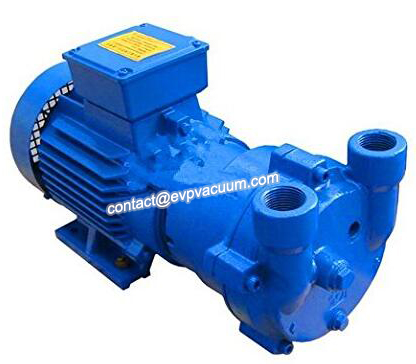Vacuum pump terminology
1. Vacuum: in vacuum science, the meaning of vacuum refers to the state of gas below an atmospheric pressure in a given space. People usually call this thin gas state vacuum state.
2. Vacuum degree: as the name implies, vacuum degree is the degree of vacuum. The thinness of gas in vacuum state is usually expressed by “high vacuum” and “low vacuum”. High vacuum means good vacuum, low vacuum means bad vacuum. The so-called “vacuum” refers to the state of gas with pressure lower than 101325 Pascal (i.e. a standard atmospheric pressure is about 1013hpa) in a given space. In the vacuum state, the rarefied degree of gas is usually expressed by the pressure value of gas. Obviously, the smaller the pressure value is, the thinner the gas is.
3. Vacuum pump limit pressure: the minimum pressure that vacuum pump can reach.
4. Limit vacuum: after the vacuum vessel is fully pumped, it is stable in a certain vacuum degree, which is called limit vacuum. In general, the vacuum vessel shall be subject to 12 hours of gas refining, 12 hours of vacuum pumping, and the last hour shall be measured every 10 minutes. The average value of 10 times shall be taken as the limit vacuum value.
5. Atmospheric pressure: the pressure on the earth’s surface or surface objects caused by a thick atmosphere surrounding the earth’s surface is called atmospheric pressure.
6. Standard atmospheric pressure: refers to the atmospheric pressure at sea level under standard atmospheric conditions. 1 standard atmospheric pressure = 760mmhg = 101325 pa
7. Absolute pressure and relative pressure: the pressure directly acting on the surface of the container or object, which is called absolute pressure. The absolute pressure value takes absolute vacuum as the starting point. The pressure measured by pressure gauge, vacuum gauge, U-tube and other instruments is called gauge pressure or relative pressure.
8. Standard condition: it usually refers to the condition with temperature of 0 ℃ and pressure of 101325pa (1 standard atmospheric pressure, 760mm Hg). So that there is a unified standard when comparing gas volume. The density of a gas, unless otherwise specified, refers to the standard condition.
9. Pumping rate: under a certain pressure and temperature, the volume of gas pumped from the pump inlet in unit time is called pumping rate. Pumping speed for short.
10. Main pump: in a vacuum system, a vacuum pump used to obtain the required vacuum to meet the specific process requirements.
11. Pre stage pump: a vacuum pump used to maintain the pre stage pressure of a vacuum pump lower than its critical pre stage pressure. For example, the rotary vane or liquid ring pump in front of Roots vacuum pump of Roots vacuum unit is the front stage pump.
12. Vacuum gauge: an instrument used to measure vacuum.
13. Vacuum system: it is composed of vacuum pump, vacuum gauge, pumped vessel and other components such as vacuum valve, cold well, etc. with the aid of vacuum pipe, it is combined according to certain requirements and has the required pumping function. Its function is to obtain and maintain a vacuum in a specified time and space, so as to ensure the implementation of a process or physical process in the system.
14. Saturated steam: when the liquid evaporates in a limited confined space, the liquid molecules enter the upper space through the liquid surface and become steam molecules. Because steam molecules are in a turbulent thermal motion, they collide with each other, and collide with the container wall and the liquid surface. When they collide with the liquid surface, some molecules are attracted by the liquid molecules, and return to the liquid to become liquid molecules. At the beginning of evaporation, the number of molecules entering the space is more than the number of molecules returning to the liquid. As the evaporation continues, the density of space vapor molecules increases, so the number of molecules returning to the liquid also increases. When the number of molecules entering the space in unit time is equal to the number of molecules in the returned liquid, evaporation and condensation are in a dynamic equilibrium state. At this time, although evaporation and condensation are still in progress, the density of steam molecules in the space is no longer increased, and the state at this time is called saturation state. The liquid in saturated state is called saturated liquid, and its corresponding steam is saturated steam, but it is only wet saturated steam at first, and it is dry saturated steam after the water in the steam completely evaporates. The temperature of steam from unsaturated to wet and then to dry saturation does not increase. If it is heated continuously after dry saturation, the temperature will rise and become superheated steam.
15. Saturated vapor pressure: vapor pressure refers to the vapor of the substance existing on the surface of the liquid (or solid), and the pressure of the vapor on the surface of the liquid is the vapor pressure of the liquid. For example, there is water vapor pressure on the surface of water. When the vapor pressure of water reaches the total gas pressure on the surface of water, the water will boil. We usually see water boil, that is, at 100 ℃, the vapor pressure of water is equal to one atmosphere pressure. Vapor pressure changes with temperature. The higher the temperature is, the greater the vapor pressure is. Of course, it is also related to the type of liquid. At a certain temperature, the pressure generated by the vapor in equilibrium with the liquid (or solid) of the same substance is called saturated vapor pressure, which increases with the increase of temperature.


